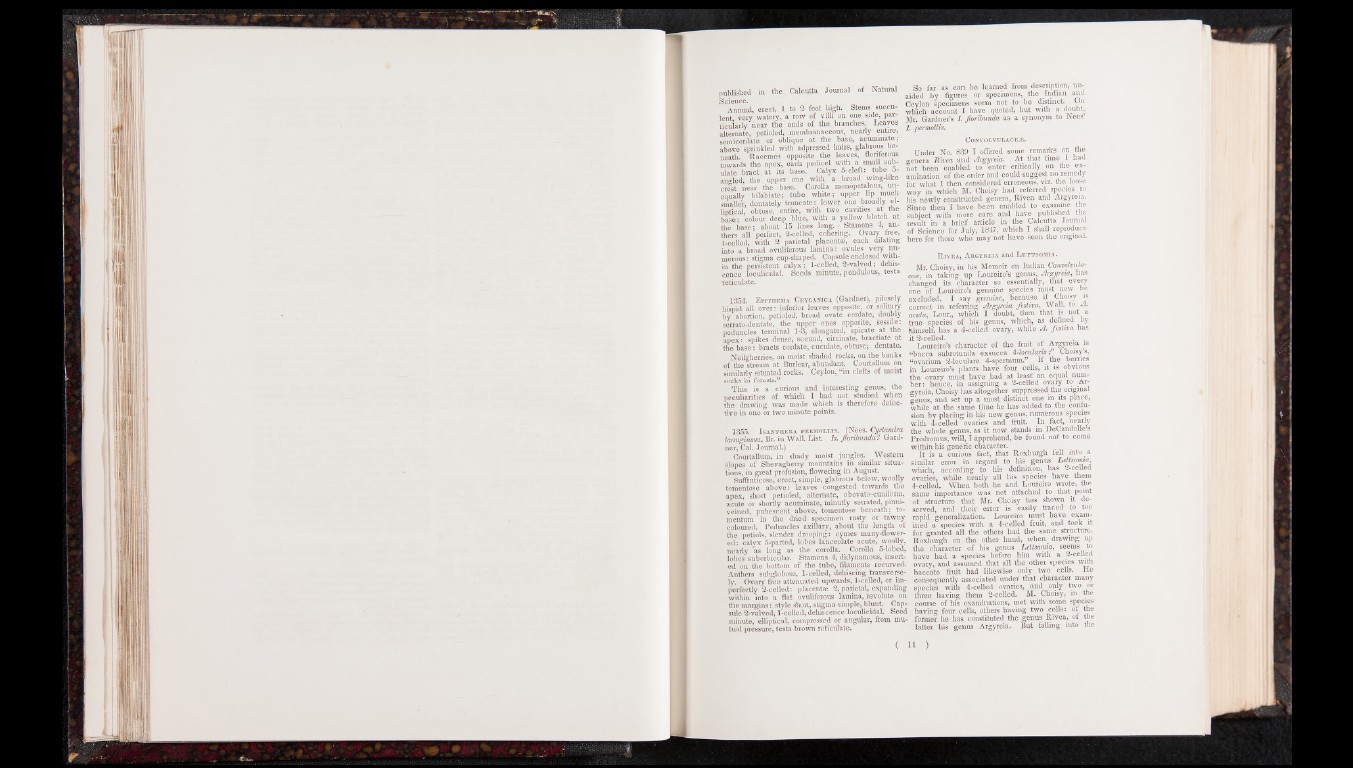
published in the Calcutta Journal of Natural
Science.
Annual, erect, 1 to 2 feet high. Steins succulent
very watery, a row of villi on one side, particularly
near the ends of the. branches. Leaves
alternate, petioled, membranaceous, nearly entire,
seinicordate or oblique at the base, acuminate;
above sprinkled with adpressed hairs, glabrous beneath.
'Racemes opposite the leaves, floriferous
towards the apex, each pedicel with a small subulate
bract at its base. Calyx 5-cleft: tube 5-
angled, the upper one with a broad wing-like
crest near the base. Corolla monopetalous, unequally
bilabiate; tube white; upper lip much
smaller, dentately truncate: lower one broadly elliptical,
obtuse, entire, with two cavities at the
base; colour deep blue, with a yellow blotch at
the base; about 15 lines long. Stamens 4- anthers
all perfect, 2-celled, cohering. Ovary free,
1-celled, with 2 parietal placentas, each dilating
into a broad ovuliferous lamina: ovules very numerous:
stigma cup-shaped. Capsule enclosed within
the persistent calyx; 1-celled, 2-valved; dehis- I
cence loculicidal. Seeds minute, pendulous, testa
■reticulate.
1354. Epithema Ceyeanica (Gardner), pilosely
hispid all over: inferior leaves opposite, or solitary
by abortion, petioled, broad ovate cordate, doubly
serrato-dentate, the upper ones opposite, sessile:
peduncles terminal 1-3, elongated, spicate at the |
apex: spikes dense, secund, circinate, bractiate at
the b a se : bracts cordate, cueulate, obtuse; dentate.
Neilgherries, on moist shaded rocks, on the banks
<rf the stream at Biirlear, abundant. Courtallum on
similarly situated rocks. Ceylon, “in clefts of moist
rocks in forests.”
This is a curious and interesting genus, the
peculiarities of which I had not studied when
the drawing was made which is therefore defective
in one or two minute points.
1355. I santhera permollis. (Nees. Cyrtandra
lanuginosa, Br. in Wall. List. Is. Jloribunda? Gardner,
Cal. Journal.)
Courtallum, in shady moist jungles. Western
slopes of Shevagherry mountains in similar situations,
in great profusion, flowering in August.
Suffruticose, erect, simple, glabrous below, woolly
tomentose above: leaves congested towards the
apex, short petioled, alternate, obovato-cuniform,
acute or shortly acuminate, minutly serrated, pinni-
veined, pubescent above, tomentose beneath; to-
mentum in the dried specimen rusty or tawny
coloured. Peduncles axillary, about the length of
the petiols, slender drooping: cymes many-flowered:
calyx 5-parted, lobes lanceolate acute, woolly,
nearly as long as the corolla. Corolla 5-lobed,
lobes suborbicular. Stamens 4, didynamous, inserted
on the bottom of the tube, filaments recurved.
Anthers subglobose, 1-celled, dehiscing transversely.
Ovary free attenuated upwards, 1-celled, or imperfectly
2-celled: placentae 2, parietal, expanding
within into a flat ovuliferous lamina, revolute on
the margins: style short, stigma simple, blunt. Capsule
2-valved, 1-celled, dehiscence loculicidal. Seed
minute, elliptical, compressed or angular, from mutual
pressure, testa brown reticulate.
So far as can be learned from description, unaided
by figures or specimens, the Indian and
Ceylon specimens seem not to be distinct. On
which account I have quoted, but with a doubt,
Mr. Gardner’s I. jloribunda as a synonym to JNees
i. permollis.
CoNVOLVOLACE-ffi.
Under No. 889 I offered some remarks on the
genera Rivea and Argyreia. At that time I had
not been enabled to enter critically on the examination
of the order and could suggest no remedy
for what I then considered erroneous, viz. the loose
way in which M. Choisy had referred species to
his newly constructed genera, Rivea and Argyreia.
Since then I have been enabled to examine the
subiect with more care and have published the
result in a brief article in the Calcutta Journal
of Science for July, 1847, which I shall reproduce
here for those who may not have seen the original.
R ivea, Argyreia and L ettsomia.
Mr. Choisy, in his Memoir on Indian Convolvula-
cece. in taking up Loureiro’s genus, Argyreia, has
changed its character so essentially, that every
one of Loureiro’s genuine species must now be
excluded. I say genuine, because if Choisy is
correct in referring Argyreia festiva, Wall, to Jl.
acuta, Lour., which I doubt, then that is not a
true species of his genus, which, as defined by
himself, has a 4-celled ovary, while A. /estiva has
it 2-celled. .... - . .
Loureiro’s character of the fruit of Argyreia is
“bacca subrotunda exsucca i - l o c t d a n s Choisy s,
“ovarium 2-loculare 4-spermum.” I f the b ernes
in Loureiro’s plants have four cells, it is obvious
the ovary must have had at least an equal number:
hence, in assigning a 2-celled ovary to Argyreia,
Choisy has altogether suppressed the original
genus, and set up a most distinct one in its place,
while at the same time he has added to the confusion
by placing in his new genus, numerous species
with 4-celled ovaries and fruit. In fact, nearly
the whole genus, as it now stands in DeCandolle s
Prodromus, will, I apprehend, be found not to come
within his generic character.
It is a curious fact, that Roxburgh fell into ^ a
similar error in regard to his genus Lettsorma,
which, according to his definition, has 2-celled
ovaries, while nearly all his species have them
4-celled. When both he and Loureiro wrote, the
same importance was not attached to that point
of structure that Mr. Choisy has shown it deserved,
and their error is easily traced to too
rapid generalization. Loureiro must have examined
a species with a 4-celled fruit, and took it
for granted all the others had the same structure.
Roxburgh on the other hand, when drawing up
the character o f his genus Lettsomia, seems to
have had a-species before him with a 2-celled
ovary, and assumed that all the other species with
baccate fruit had likewise only two cells. He
consequently associated under that character many
species with 4-celled ovaries, and only two or
three having them 2-celled. M. Choisy, in the
course of his examinations, met with some species
having four cells, others having two cells: of the
former he has constituted the genus Rivea, of the
latter his genus Argyreia. But falling into the